New IP DECT from Grandstream DP715 / DP710

Already a well-known manufacturer of VoIP telephony devices has entered the market with a budget solution for cordless phones. The solution consists of two positions - a DECT handset complete with a base station (it is also a stand for the device and charging) is called the DP715. Overview under the cut.

')
A DECT tube without a base complete with a charging stand is called the DP710.

The fact is that up to 5 handsets can be registered to one base, each with either a personal number or in a group with other handsets. Phones in groups can call at the same time or use one line, like parallel connected analog telephones, calls to them can also be received either one by one or at the same time. Handsets, of course, can transfer calls, set yourself call forwarding, do not disturb, there is a speakerphone, etc.
It is also interesting that each handset can be registered on 4 bases simultaneously. This will allow phones to work, even if they are beyond the reach of their home base.
I’ll just make a reservation that this is not a full-featured DECT system for enterprises, which ensures seamless transfer of conversation from base to base, but I will describe in more detail how to organize (with certain restrictions) mobile communication over a large area.
Short review
Base
Tabletop There is an indication of power, network availability, registration and employment.

Behind, unfortunately, there is neither a switch for connecting a computer, nor additional FXS or FXO interfaces.
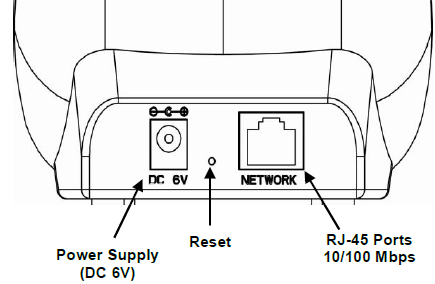
If anyone is interested in the web base configuration interface, everything can be viewed here:
dp715_gui.zip
A tube
The tube is completely plastic, rather light, it fits comfortably in your hand, but it is a bit long enough to fit in any pocket. The keys are all in reach of the thumb, not small. The screen backlight is blue.
Batteries included, regular AAA fingertips, 500mAh
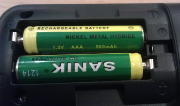
C control is simple and convenient:

the left key is the entrance to the phone book, the right key is in the menu.
4-way up-down key - access to logs of dialed and unanswered calls, to the left - direct access to other handsets on this base (Intercom), to the right - call transfer (Recall).
If you press the green key a second time, talk through the speaker.
The Russian language is supported, the display shows the name of the handset that the user himself sets up, and behind him the number from 1 to 5 shows the number of the handset in the database (Intercom number).
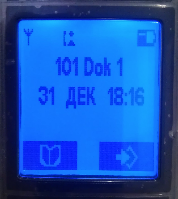
Reflections on the use cases
Initially, of course, the DP71X tubes are ideal for a home, a large house, separate small offices, or warehouses. The complete configuration is considered to be one base with five tubes. However, the size of the territory covered by a single DECT base is limited to 50 meters in circumference.
I want to tell you how to increase the coverage area, if you place several base stations on the territory. To do this, you must register the handsets at each of the bases under the auxiliary numbers and provide dialing to them.
For example, we need to register a subscriber with number 101 on several bases.
We pick up the phone on our base at number 101, on the second base in second place as 2101, in third place - in third place as 3101 and so on:
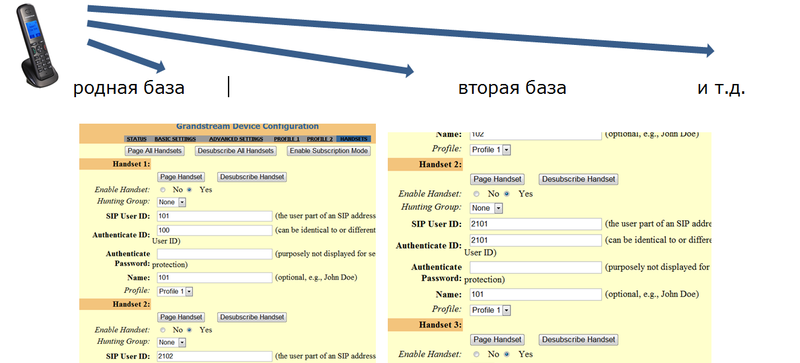
We register on all bases
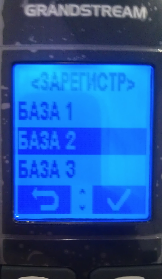
and set auto-select

Then in the IP PBX set the redirection from one number to another by the condition of inaccessibility. This will ensure dial-up to the tube, no matter what zone it is in.
In Asterisk, for example, if you are using FreePBX, it can be done like this:
On the auxiliary numbers, we configure the Outbound CID of the main number to display correctly:
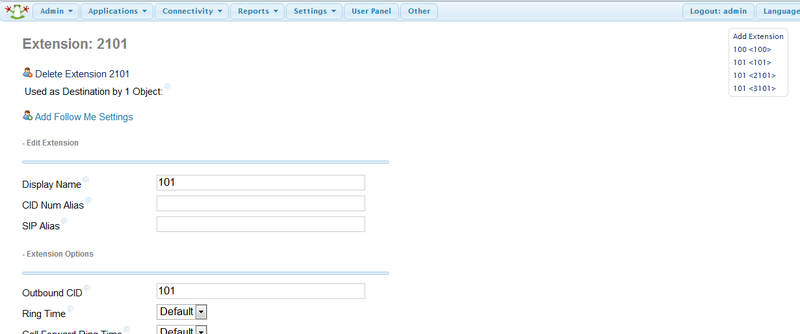
and set up forwarding for unavailability to the following auxiliary number:

What could be the features of such a system:
First, of course, when moving from the zone of one base to another, the conversation will end as soon as the handset completely loses the signal of the first base, i.e. Handover will not work. We'll have to call back.
Secondly, if you want to configure such functions as “do not disturb” on the phone, immediate redirection, then you need to do this only after making sure that your handset has chosen its home base (the number 1 should appear on the display after the handset name).
However, it is generally necessary to set up call forwarding by non-response or busy on both the main and sub-numbers of the handset. In the same Asterisk, I think, all this can be solved if desired with the help of additional writing of macros.
If IP ATC requires licensing the number of SIP subscribers, then you need to remember that the total number of licenses required is the product of the number of handsets and the number of databases.
A significant disadvantage is that the DECT bases do not hang on the walls, are also charging devices for the tube and are thus tied to the workplaces of employees. It can be difficult to mark them up as required to cover the entire territory, so this solution is not always applicable. However, in hotels / hospitals, where maid / nursing rooms are located on each floor, or for security, where posts are distributed throughout the territory, this can be a good budget solution.
Briefly about prices
. The DP715 costs $ 85. The DP710 costs $ 47.Such a system can consist of up to 5 mobile subscribers and four DECT bases.

and cost $ 85 x4 + $ 47 = $ 387. Not bad, what do you think?
I will add that the bases also support tubes from other manufacturers via the GAP protocol. I tested the Siemens handset from the C595IP kit. All the basic functions — displaying IDs, transferring calls — everything worked perfectly.
Specifications:
Main features
• Base station DECT allows you to simultaneously register up to 5 DECT tubes and to conduct up to 4 parallel conversations
• If you use one SIP account for several handsets, the Hunting Group supports the following modes:
- Linear mode: all phones ring sequentially in a pre-configured order;
- Group line mode: all phones ring at the same time and use one line on the principle of analog
phones;
- Parallel mode: all phones ring at the same time, and after one phone answers, the remaining free phones can be used for further calls.
• Advanced telephony features, including reflection of the caller’s number, notification of incoming
Talk, three-way conference call, call transfer, call forwarding, incoming call barring,
indication of a voice message, answering machine, voice prompts with multi-language support, flexible order
recruitment
• Support for integrated voice codecs, including G.711, G 723.1, G 729A / B, G.726 and iLBC
• Communication security through the use of SIP protocols over TLS and SRTP
• Automatic provisioning using HTTP / HTTPS / TFTP / AES-256
• Call duration - 10 hours, standby time - 80 hours, charging time - 16 hours
Specification

MUK-Service - all types of IT repair: warranty, non-warranty repair, sale of spare parts, contract service
Source: https://habr.com/ru/post/148708/
All Articles